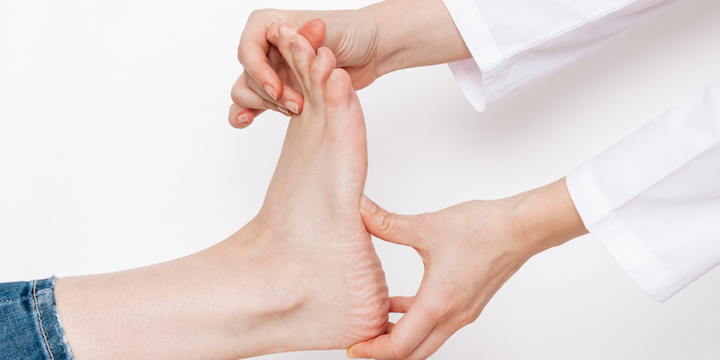
It is often said that of the complications of living with diabetes
- Heart Disease is the most common
- Blindness is the most feared
- Erectile Dysfunction is the least talked about
- Neuropathy is the hardest to live with…
What is diabetic neuropathy?
Like other small blood vessels in the body that can be affected by diabetes, the blood vessels that supply the nerves can also be damaged by high blood sugars. The most common type of nerve damage or neuropathy is the type that affects both sides of the body (sensorimotor polyneuropathy). It generally starts at the tips or bottoms of the feet and spreads up the legs. This can also start in the tips of the fingers but usually appears after symptoms in the feet.
Often this starts out as a ‘numb’ feeling or as if you are walking on ‘cotton balls’. Sometimes it can go unnoticed until a skin ulcer develops. This is because some damage happened that wasn’t noticed due to lack of sensation. Often too, the feeling is painful, “burning or prickly” in the feet and legs, or there is an over sensitivity to touch, like being bothered by the sheets at night.
There are also neuropathies that can just affect one nerve. For example, there is one that controls the motor function of the eye, so the person with diabetes may present with double vision. Even though these are scary nerve complications, they usually resolve completely. Finally, people with diabetes are also more prone to nerve “entrapments” like carpal tunnel.
How common is diabetic neuropathy and what are the risk factors?
Polyneuropathy will affect 40 to 50% of people with type 1 diabetes or type 2 diabetes within 10 years of the start of their disease. Duration of diabetes and poorly controlled blood sugars will increase the likelihood of getting neuropathy. Women are affected more often than men. Independent risk factors for developing neuropathy include smoking, being obese, and having high cholesterol and high blood pressure.
When should someone with diabetes be checked for neuropathy?
People with type 1 diabetes should be screened 5 years after their diagnosis and people with type 2 diabetes, at the time of diagnosis. Both should be checked yearly thereafter. Unfortunately, some people can present with a painful neuropathy as the first symptom of their diabetes!
How is neuropathy diagnosed?
People with diabetes may be given a questionnaire asking about loss of sensation or increased pain in their feet. It will help the healthcare professional if the person with diabetes mentions that they have noticed a change in sensation (can’t feel the temperature of the bath water, can’t feel crumbs on the kitchen floor).
The test to detect neuropathy is usually a small piece of nylon that bends when it touches the skin (a monofilament). This is applied to various areas of the foot to determine the ability to feel. It is a good predictor of future amputation risk if the person with diabetes can’t feel this. Another method is with a tuning fork that vibrates and is put on the big toe to see if the vibration can be felt.
It is important to be sure there are not other issues that can cause or worsen neuropathy such as alcohol use, nutritional deficiencies (B12), low thyroid or kidney failure.
How is neuropathy treated?
First, prevention is best. There is very good evidence in type 1 diabetes that excellent control will help reduce the chance of getting neuropathy. In type 2 diabetes, good sugar control can reduce the chances of getting neuropathy, but unfortunately for some people it can develop even prior to diabetes and even with good control.
If there is neuropathy and lack of feeling in the feet, the really important issue is to prevent diabetic ulcers by making sure there isn’t undue pressure on certain areas on the feet. This will sometime require orthotics and certainly well-fitted shoes. A daily foot check is important and should be part of your self-management routine.
There are several medications that can be used to treat the pain of neuropathy. These include and sometimes require combining: amitriptyline or nortriptyline, gabapentin (Neurontin®) or pregabalin (Lyrica®), narcotic agents (e.g. morphine, tramadol). You may wish to discuss these options with your physician.
For more information, see my previous blog on foot care


